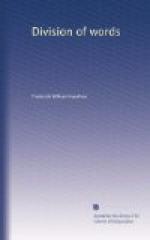Th has two sounds, soft, or surd, as in thin and death, and hard, or sonant, as in then and smooth.
S has two sounds, soft, or surd, as in soft and this, and hard, or sonant, as in has and wise.
We have, therefore, twenty-six letters with which to express fifty or more sounds, not counting the digraphs and diphthongs.
Correct pronunciation depends upon three things, correct sounding of the letters, correct division into syllables, and correct placing of the accent.
A syllable is the smallest separately articulated, or pronounced, element in speech, or one of the parts into which speech is broken. It consists of a vowel alone or accompanied by one or more consonants and separated by them, or by a pause, from a preceding or following vowel. This division of words into syllables is indicated in dictionaries by the use of the hyphen thus: sub-trac-tion, co-or-din-ate. It will be observed that in the first of these examples the vowels are all separated by consonants, while in the second two of them are separated by a pause only.
The English language has the further peculiarity of using l and n as vowels in syllabication, as in middle (mid-dl) and reck-on (reck-n).
The division of words into syllables for pronunciation is generally, but not always, the same as that which should be followed in case the word has to be divided typographically. As these text-books are intended to help the apprentice as a speaker and writer of English as well as a printer, it is worth while to give some attention to syllabication for pronunciation before proceeding to discuss typographical division.[The illustrations from this point to the end of this section on page 16 are not typographic divisions. They concern pronunciation only.]
Two letters forming a diphthong or digraph are not to be separated. Coin-age (oi diphthong) but co-in-ci-dence (oi not a diphthong). Excess (ss digraph, pronounced practically like a single s) gives ex-cess-es, ex-cess-ive, etc. Whether or not the letters thus occurring together form a diphthong or digraph will depend on the derivation of the word, thus in cat-head (verb), a nautical term, th is not a digraph but in ca-the-dral th is a digraph, as is usually the case with these two letters. You would not say cat-hed-ral.
Two vowels, or a vowel and a diphthong, coming together but sounded separately belong to separate syllables.
A-or-ta, co-op-er-ate, but coop-er-age, moi-e-ty.
Do not end a syllable with
(a) c
or g when soft, en-ti-cing, but dic-tion,
wa-ges
but wag-on.
(b) t,
s, z, c, sc, g,
and d, when followed by i
or e giving the
sound of sh; ra-tion-al, o-cean,
re-gion,
as-cen-sion.




